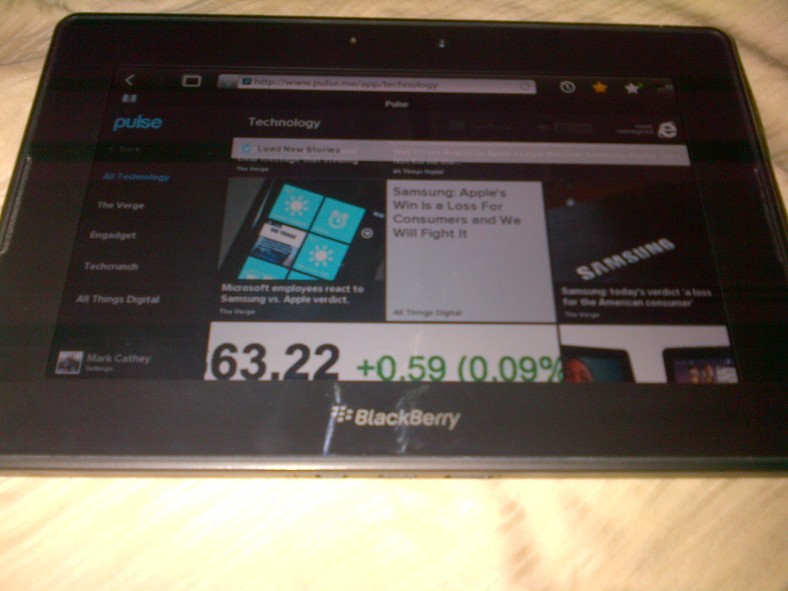
RIM has been developing a system designed to securely manage credentials on SIM cards that will work on all types of various mobile devices to bring NFC payment capabilities to consumers.
EnStream LP, the joint venture between Bell Mobility Inc., Rogers Wireless Partnership and TELUS Communications Company announced today that RIM’s Secure Element Manager Solution is to be used to power NFC mobile payments in Canada.
“Working with EnStream, we’re delivering a service that will enable speed, security and convenience in mobile, contactless payment. RIM’s SEM solution will help deliver mobile payments and other NFC services to all carriers across all handset platforms that support NFC technology in Canada.” According to Andrew MacLeod, Managing Director for Canada at RIM.
Press Release
RIM’s Secure Element Manager Solution to Power NFC Mobile Payments in Canada
WATERLOO, ONTARIO–(Marketwire – Oct. 22, 2012) – Research In Motion (RIM) (NASDAQ:RIMM)(TSX:RIM) today announced that it has been selected by EnStream LP, a joint venture of Bell Mobility Inc., Rogers Wireless Partnership and TELUS Communications Company, to provide its Secure Element Manager (SEM) solution to manage credentials on wireless handsets in Canada that support Near Field Communication (NFC) services. NFC is the technology that can make secure, convenient and contactless mobile payments a reality for Canadian wireless handset users.
RIM’s SEM solution is designed to securely manage credentials on SIM (subscriber identity module) cards installed in all types of mobile devices, including BlackBerry® smartphones, Android™ devices, and Windows phones. “We selected RIM for their long-standing relationships with mobile operators and financial institutions, and their track record of operating a secure network for connected services,” said Almis Ledas, Chief Operating Officer of EnStream. “By adopting the secure GSMA Global Platform standard and using SEM infrastructure hosted and operated by RIM, consumers and financial institutions can have full confidence in financial credentials enabled through EnStream.”
“More than 1 in 4 smartphones shipped worldwide in 2013 is expected to include NFC technology,” said senior practice director Jeff Orr of market intelligence firm ABI Research. “With an additional 5 million NFC-enabled smartphones shipping to Canada next year and upwards of 65 million over the next 5 years, consumers will increasingly turn to mobile payments instead of a separate debit or credit card.”
“RIM is very pleased to play a key role in this Canadian mobile payments solution,” said Andrew MacLeod, Managing Director for Canada at RIM. “Working with EnStream, we’re delivering a service that will enable speed, security and convenience in mobile, contactless payment. RIM’s SEM solution will help deliver mobile payments and other NFC services to all carriers across all handset platforms that support NFC technology in Canada.”
Through the infrastructure that RIM’s SEM solution provides, financial institutions in Canada will have a single gateway allowing them to support any customer with an NFC-enabled smartphone that wants to enable a “mobile wallet” application. RIM’s SEM solution provides the infrastructure that will securely manage information credentials for NFC payments, which can be used by any financial institution, carrier, or smartphone.
“For banks and for Canadian consumers, RIM’s SEM solution is designed to make payment with your smartphone both seamless and secure. Whether you’re filling your gas tank, picking up a coffee, or buying groceries, making a purchase will be as simple as tapping your smartphone,” added MacLeod.
RIM has been recognized as a leader in providing mobile payments for some time with BlackBerry smartphones becoming one of the first smartphones to be certified for SIM-secure NFC payments using MasterCard PayPass®, and are also approved for use with Visa® payWave. More recently, RIM announced the ability to use NFC-enabled BlackBerry smartphones to replace access badges for buildings with secure entry requirements.
Currently, a range of BlackBerry® 7 smartphones, including the BlackBerry® Bold™ series and select BlackBerry® Curve™ smartphones, are NFC-enabled.
About Research In Motion
Research In Motion (RIM), a global leader in wireless innovation, revolutionized the mobile industry with the introduction of the BlackBerry® solution in 1999. Today, BlackBerry products and services are used by millions of customers around the world to stay connected to the people and content that matter most throughout their day. Founded in 1984 and based in Waterloo, Ontario, RIM operates offices in North America, Europe, Asia Pacific and Latin America. RIM is listed on the NASDAQ Stock Market (NASDAQ:RIMM) and the Toronto Stock Exchange (TSX:RIM). For more information, visit www.rim.com or www.blackberry.com.
Forward-looking statements in this news release are made pursuant to the “safe harbor” provisions of the U.S. Private Securities Litigation Reform Act of 1995 and applicable Canadian securities laws. When used herein, words such as “expect”, “anticipate”, “estimate”, “may”, “will”, “should”, “intend,” “believe”, and similar expressions, are intended to identify forward-looking statements. Forward-looking statements are based on estimates and assumptions made by RIM in light of its experience and its perception of historical trends, current conditions and expected future developments, as well as other factors that RIM believes are appropriate in the circumstances. Many factors could cause RIM’s actual results, performance or achievements to differ materially from those expressed or implied by the forward-looking statements, including those described in the “Risk Factors” section of RIM’s Annual Information Form, which is included in its Annual Report on Form 40-F (copies of which filings may be obtained at www.sedar.com or www.sec.gov). These factors should be considered carefully, and readers should not place undue reliance on RIM’s forward-looking statements. RIM has no intention and undertakes no obligation to update or revise any forward-looking statements, whether as a result of new information, future events or otherwise, except as required by law.
The BlackBerry and RIM families of related marks, images and symbols are the exclusive properties and trademarks of Research In Motion Limited. RIM, Research In Motion and BlackBerry are registered with the U.S. Patent and Trademark Office and may be pending or registered in other countries. All other brands, product names, company names, trademarks and service marks are the properties of their respective owners. RIM assumes no obligations or liability and makes no representation, warranty, endorsement or guarantee in relation to any aspect of any third party products or services.









